

The distinguished Czech painter Mikolas Ales was born in the ancient town of Mirotice in the Prachensko region of South Bohemia.
 Ales
was of South Bohemian ancestry, whose individuals are
characteristically thoughtful, straightforward, and of unyielding
principles.
Ales
was of South Bohemian ancestry, whose individuals are
characteristically thoughtful, straightforward, and of unyielding
principles.
Ales' family came to Mirotice from Pisek early in 18th century.
They soon achieved such a prominent position that members were
elected as aldermen and mayors. They owned one of the biggest
homesteads in Mirotice, called Alsovna, which is a derivation of
their family name. The family achieved its highest level of
prosperity under the mayor Kaspar Ales, whose economic renown
brought him on close terms with Count Vratislav of Mitrovic who
he urged to establish farmstead Karlov,
near Smetanova Lhota.
His son, Kaspar Frantisek, was a good and pious man, but a bad
landlord who got into debt as a result of his expensive lifestyle.
This resulted in the executory auction of his house in 1873 and
put an end to the burgess glory of Ales' family. Frantisek, the
eldest of seven siblings, experienced the decline of the family
fortunes but was still able to obtain a thorough education in the
Latin schools in Pisek.
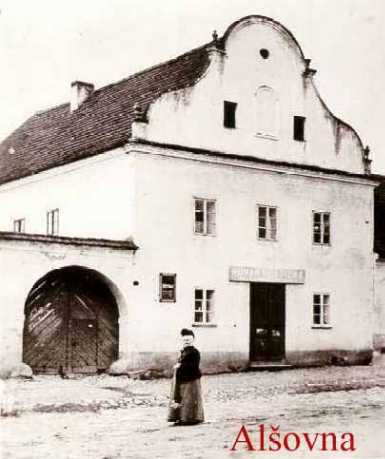 Unfortunately, he could not
finish his philosophy studies in Prague due to a lack of funding
so he had to work at manors in Cerhonice, Varvazov,
and Mirotice. Then he served as a border guard for three years
but he was glad to return home and earn his living as a penman in
Mirotice and its surroundings. At the end of his life, he became
a town clerk.
Unfortunately, he could not
finish his philosophy studies in Prague due to a lack of funding
so he had to work at manors in Cerhonice, Varvazov,
and Mirotice. Then he served as a border guard for three years
but he was glad to return home and earn his living as a penman in
Mirotice and its surroundings. At the end of his life, he became
a town clerk.
Mikolas Ales described him using these words: "A little bit
of a student always remained in my father. He was good at Latin
and used to recite and play in amateur theatre. I remember him on
stage wearing his knight's attire and declaiming the Three Eras
of the Czech Lands. He was of a small stature, but a heavyset,
square-shouldered man with thick, curly hair, blue eyes, and
conjugate, beetled brows. My father was good-natured. Although he
was quick-tempered, he never beat us. His needs were quite modest;
his only indulgence was a tumbler of good beer. As a mentor, he
was honest with people in the neighbourhood and often helped them
for nothing."
Frantisek married Veronika Fanfule in 1846. Through this marriage
he got a small, thatched cottage at the end of Rybarska Street,
which was beneath a church on a high shore above the Lomnice
River. A twisting flow of water lined with willows and alders
under a broadly arching sky, the Mirotice valley could be seen
from the small windows of the cottage. This was the only wealth
the humble cottage offered, but there was the peace and fatalism
of poor people.
Mikolas' mother Veronika was a common woman gifted with the sense
of goodness and love. She liked reading, singing, and telling old
legends, and was very skilful at drawing patterns for her
embroideries. Tomas Famfule was Veronika's brother and a
cavalryman who had been in the Napoleonic Wars. He was another
member of Ales' family.
Tomas Famfule graduated as a tailor and then spent 14 years in
military service when he saw foreign countries and cities,
including Rome and Naples. He was a good observer and storyteller.
When young Mikolas was born, his father announced the news to his
brother Vincenc by letter: "This year our family was
enlarged by another son, born on the 18th November 1852, just a
day before his grandmother's name day. He was named Mikolas after
his godfather Sichrovsky and is in good health." Young
Mikolas was the third son of the Mirotice clerk. His brothers Jan
and Frantisek were four and six years older respectively. They
were both good painters, but Jan excelled in drawing.
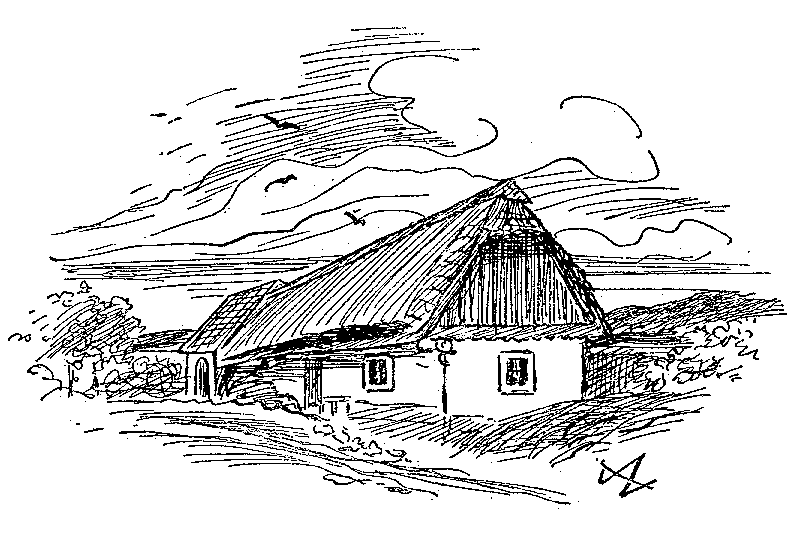 As a young
boy, Mikolas got his first
life experiences in Mirotice, around the area of the small,
thatched cottage where he was born. This was near the river where
he used to go with his father, who was a passionate angler. It
was there, as he himself said later, that he memorised the
details of the crickets, beetles, grasshoppers, butterflies, and
spotted ladybirds moving above colourful flowers that, as a
mature man, he put into his drawings in his simple but beautiful
way.
As a young
boy, Mikolas got his first
life experiences in Mirotice, around the area of the small,
thatched cottage where he was born. This was near the river where
he used to go with his father, who was a passionate angler. It
was there, as he himself said later, that he memorised the
details of the crickets, beetles, grasshoppers, butterflies, and
spotted ladybirds moving above colourful flowers that, as a
mature man, he put into his drawings in his simple but beautiful
way.
When he was older he ventured with his brothers to the spacious
square in Mirotice, where he found a new and fascinating world of
indelible impressions. There he saw austere, old-world burghers
riding in their carriages. He also saw carrier's coaches, gypsies,
comedians, village women, farmers wearing leather trousers, and a
white-bearded Jew carrying a bag. All these characters he
retained vividly in his early childhood memories, we can see in
his book, Spalicek.
Let us imagine him muffled in a coat on the frozen river Lomnice,
on a hillside below the Buda manor house
or on a steep road to Cerhonice. Let us imagine him the same way
that he drew so many times the small, roly-poly boys breathing on
their hands in the biting winter frost.
 Mikolas had a
happy childhood, despite the difficulties his father had to earn
their daily bread. The family sold their cottage and moved to
Pisek and then later to Prague. Both towns were a source of new
impressions for the young boy: well-built buildings, town squares
with public fountains, well-dressed townsfolk, and especially the
cavalry that he liked to draw. Neither town offered much hope of
success to the family and they eventually returned to Mirotice.
Mikolas had a
happy childhood, despite the difficulties his father had to earn
their daily bread. The family sold their cottage and moved to
Pisek and then later to Prague. Both towns were a source of new
impressions for the young boy: well-built buildings, town squares
with public fountains, well-dressed townsfolk, and especially the
cavalry that he liked to draw. Neither town offered much hope of
success to the family and they eventually returned to Mirotice.
On the way from Prague, they stopped at the inn called U Heinzu.
It was there that six-year old Mikolas drew his first picture of
St Wenceslas, and was rewarded by the innkeeper's daughter with a
piece of sugar. Much later he told the story: "As far as I
can remember, I was always drawing, at least since I was four. It
was winter then and we rode with mother on a carrier's coach from
Prague, and on the way we stopped at an inn. I was sitting there
on a low stool and was drawing St Wenceslas on a piece of paper.
The young innkeeper's daughter and a stitching tailor by the
window were my first admirers - a piece of sugar was my first
remuneration. I was never given such sweet royalty after."
The stay in Prague was just a short chapter in Ales life. His
return to the country and the natural world of South Bohemian was
good for his further artistic growth. He remembered the times in
his letter to his friend Alois Jirasek: "I can see myself as
a young boy going to my uncle, a gingerbread maker, for a huge
gingerbread figure of Mikulas. First I cut off its infulae, and
then, after a while, neither its crosier nor its polished shoes
remained." Another of Ales' intense childhood experiences
was a visit to his godfather Mikolas
Sichrovsky's attic. Sichrovsky carved marionettes out of wood
and dried them in the attic after applying paint. There, for the
first time, he encountered the mysterious world of wooden people
- kings, knights and princesses.
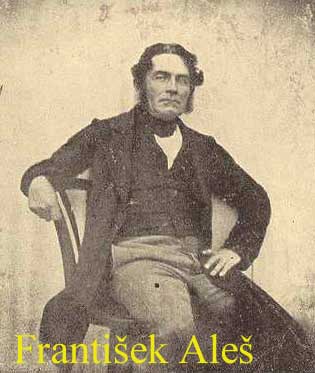 Ales
entered the school in Mirotice in 1858 and there he soon showed
his remarkable draughtsmanship. The ancient Zvikov
and Orlik castles, and the small Karlov castle near Smetanova Lhota, which
he visited during a school holiday with his brothers, impressed
him very much. His brother Frantisek, a gifted student interested
in history and geography and also a talented poet and narrator,
encouraged little Mikolas' interest in history. He also used to
go to the Buda manor house accompanied by
his brothers. There he met his future wife, Marina Kailova, then
a little girl who often chanted at him a rhyme about St Mikolas (St
Nicholas).
Ales
entered the school in Mirotice in 1858 and there he soon showed
his remarkable draughtsmanship. The ancient Zvikov
and Orlik castles, and the small Karlov castle near Smetanova Lhota, which
he visited during a school holiday with his brothers, impressed
him very much. His brother Frantisek, a gifted student interested
in history and geography and also a talented poet and narrator,
encouraged little Mikolas' interest in history. He also used to
go to the Buda manor house accompanied by
his brothers. There he met his future wife, Marina Kailova, then
a little girl who often chanted at him a rhyme about St Mikolas (St
Nicholas).
Brother Jan was also talented at drawing. They often played
cowboys and Indians together, and during these games Mikolas
learned to love nature. He often accompanied his father to the
surrounding villages. On these trips, he saw old cottages, manor
houses, ancient furniture, and costumes of farmers and peasants.
He observed closely the beggars, journeymen, jolly country
musicians with their army caps, bear leaders, and Jews going
about their business. In spring, he watched religious processions,
saw ornate statues of St. John on village greens, and children
playing games. All this he later put to his pictures and paintings,
including the summer hay harvest, harvest festivals, and autumn
and winter images of little herdsmen, kites in the wind, children
on sledges and Christmas cribs. For Ales, his childhood and
native Mirotice with its surrounding countryside were always the
most profound and happiest source of inspiration in his artistic
life.
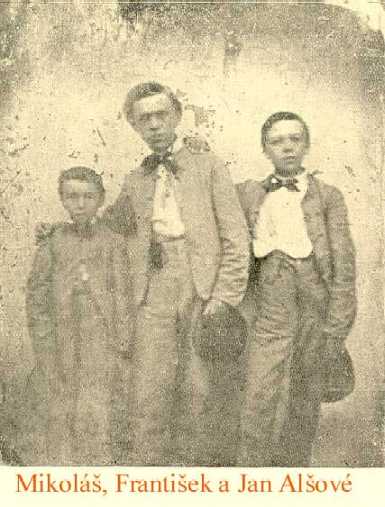 Ales
left Mirotice to study in Pisek. Uncle Tomas Fanfule looked after
him and his brothers there. After a conflict with his teacher, he
interrupted his studies for a while. A severe tragedy overwhelmed
Ales' family at this time when the oldest and very gifted son,
Frantisek, died of tuberculosis in March 1865. Unfortunately,
Mikolas' second brother also died tragically in April 1867. He
went hunting for a stork on Easter Friday with a gun. But it was
never clarified whether it was bad luck or his intention that he
died in front of his beloved girlfriend from a bullet wound to
the heart. The loss of both brothers hurt young Mikolas deeply.
He lost both his friends and his first teachers.
Ales
left Mirotice to study in Pisek. Uncle Tomas Fanfule looked after
him and his brothers there. After a conflict with his teacher, he
interrupted his studies for a while. A severe tragedy overwhelmed
Ales' family at this time when the oldest and very gifted son,
Frantisek, died of tuberculosis in March 1865. Unfortunately,
Mikolas' second brother also died tragically in April 1867. He
went hunting for a stork on Easter Friday with a gun. But it was
never clarified whether it was bad luck or his intention that he
died in front of his beloved girlfriend from a bullet wound to
the heart. The loss of both brothers hurt young Mikolas deeply.
He lost both his friends and his first teachers.
The events of the war in 1865 added more intense experiences to
the young Ales' memories. After the battle of Hradec Kralove, he
watched as the infantry marched through Mirotice. Ales, wanting
to see the famous General Radecky's cavalry, went to Cimelice, and then later to Mirovice to
see the Prussian army.
Ales was not even 17 when he left Mirotice
to go to Prague. Nevertheless, his native town with its
picturesque surroundings and the Buda manor
house where he first met his future wife remained deeply
engraved in his heart.
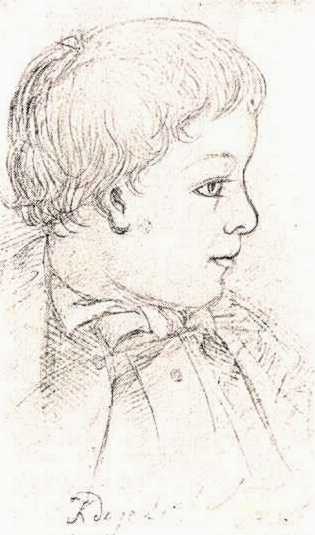
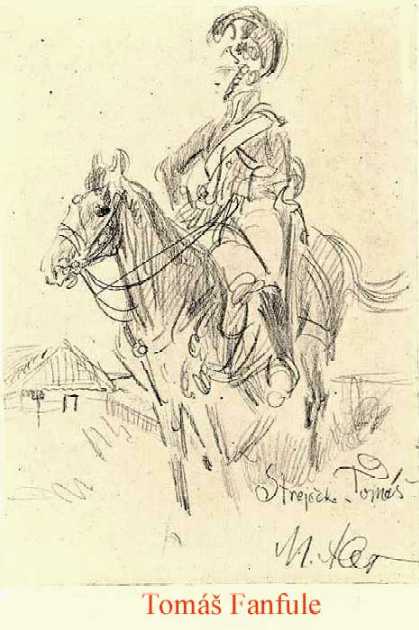
Please visit Ales' Internet gallery prepared by Mr Jaroslav Tyman in USA
MP3 (55 kB) - song "Miroticka" sung by Mr. Josef Dolejs from Mirotice.
Comments and suggestions concerning this page are welcome.
Please write to josefzak@volny.cz
Last modified: February 18, 2001
HOME